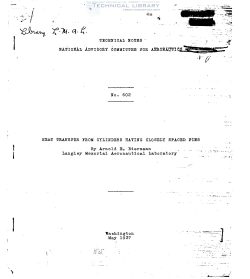naca-tn-602
- Version
- 134 Downloads
- 950.75 KB File Size
- 1 File Count
- November 25, 2016 Create Date
- November 25, 2016 Last Updated
National Advisory Committee for Aeronautics, Technical Notes - Heat Transfer Cylinders Having Closely Spaced Fins

The heat—transfer coefficients have been determined
for five steel cylinders having fins 1.22 inches wide and
the spacing between the fins ranging from 0.022_to 0.131
inch. The cylinders were tested with and without baffles
in a wind tunnel; they were also tested enclosed in jack-
ets with the cooling air supplied by a blower. '
A maximum heat transfer was reached at a fin space of
about 0.045 inch for the cylinders tested with each of the
three methods of cooling investigated. The rise in temper-
ature of the air passing between the fins and the éhange
in flow pattern were found to be important factors limit-
ing the heat transfer that may be obtained by decreasing
the fin space.
The use of baffles for directing the air around the
cylinders with closely spaced fins proved very effective
in increasing the over—all heat—transfer coefficient pro-
vided that the spacing was not appreciably less than that
for maximum heat transfer.
The results of a theoretical analysis and experimental
tests made to determine the heat dissipated from finned
cylinders have shown that the over—all heat~transfer coefe
ficient of the conventional fin construction may he in-
creased by adding more fin area. Very large rates of heat
flow may be obtained by increasing the fin width and thick-
ness. A more practical method of improving the heat trans—
fer of the conventional fin design, however, is to increase”
the fin area by reducing the space between the fins and at
the Same time to maintain optimum proportions of width,
space, and thickness. These changes result in a math
lighter and more compact fin construction for the same
heat transfer than is otherwise possible. Eor this reason
the method is the most desirable for aircraft engines.
Tests made at this.lahoratory and elsewhere have in—
dicated the need for a determination of the heat transfer
from finned cylinders having more closely spaced fins than
have hitherto been tested. The minimum fin space tested
by Taylor and Rehbock (reference 1) with rectangular cop-
per fins soldered to a flat plate was 0. 063 inch This
investigation and tests by the N. A. C. A. (reference 2) of
finned steel Cylinders having a space between fine of
0.060 inch showed that the maximum heat transfer for these
surfaces is to be obtained with a fin space less than
0.060 inch.
| File | Action |
|---|---|
| naca-tn-602 Heat Transfer Cylinders Having Closely Spaced Fins.pdf | Download |
Comment On This Post